












In 2019 before the COVID-19 pandemic hit, tourism in Hawaii hit a record 10.4 million. The pandem ic shuttered tourism, the hotels, and all businesses related to the visitors industry. During that time, as tens of thousands went from working at some of the most beautiful places in Waikiki to standing in un employment lines, workers themselves knew that the industry would never be the same.
Communities started to realize the harmful effects of over-tourism, its toll on the environment, its infiltration into neighborhoods via illegal and legal rentals. A survey by the Ha waii Tourism Authority, the agency charged with promoting Ha waii around the world, had about two-thirds of Hawaii residents say they still do not want tourists to return to the islands.
Politicians and the business community alike realized that an overreliance on tourism as the sole driver of the economy leaves the state vulnerable and new industries must be developed.
Leaders in the hospitality industries themselves started to talk about a new kind of tourism, one that is more collaborative with the local community, that promotes sustainability, preserves the environment, one where tourists should learn to respect the islands’ people, culture and history, and lastly one where locals are made to feel welcomed at their hotels.
In other words, most locals now believe in quality tourism, and not just quantity-based tourism.
This seems to be the consensus, and the overall tenor of what a new post-pandemic tourism market should be like in Hawaii.
And it’s not just in Hawaii. Other tourism havens around the world hit hard by the pandemic, are starting to reimagine what their local economies, local geography can look like with a more manageable, quality over quantity tourism market.
One hospitality industry leader joining the almost unanimous chorus among industry leaders emphasizing sustainability, envi ronmental-friendly and greater community collaboration is Joe Ibarra, General Manager of the Kahala Hotel & Resort.
At the Kahala he has spearheaded two programs designed to encourage pono (proper) actions among their guests: the Pono Guest Video and KISCA program (Kahalaʻs Initiative for Sus tainability, Culture and the Arts). The new direction the hotel is taking implements far more community outreach and input.
“If we want the tourism industry to continue to thrive, we must do a better job of building community engagement, getting community input, and thinking of how tourism impacts the dif ferent areas of our island,” Ibarra said.
They say there is a silver lining to everything, even moments of extreme hardship. On the catastrophic meltdown of tourism during the pandemic one silver lining could be -- that we get to rebuild a new tourism that most Hawaii residents and businesses can support and not feel simply exploited.
Clearly overcrowding at Hanauma Bay, its damage to the coral reef, is unstainable. So, too, is the case for other overcrowd ed tourist sites from certain state parks like Diamond Head State Monument to beaches like Waikiki, and others.
Overcrowding that damages the islands natural beauty, over exposure of Hawaii in the long run is not good for business; and that’s ultimately why tourism leaders seem to be on board with the mantra for change.
As tourism rebounds from the COVID-19 pandemic shut down, there have been talks in the commu nity and among leaders in the visi tors industry from the state to hotel heads themselves as to what a new post-pandemic tourism should resemble. Partic ularly from local communities, the consensus seems to be that it needs to undergo changes and not be the same over-tourism of the past that has taken a toll on Hawaii’s natural beauty and had visitors intruding into local residential neighborhoods via illegal and legal vacation rentals. A whopping two-thirds of Ha waii residents polled by the Hawaii Tourism Authority say they still do not want tourists to return to the islands.
For our cover story this issue, General Manager of the Kahala Hotel & Resort Joe Ibarra shares some fresh insight as to what he envisions Hawaii’s tourism could be in this post-pandemic era. HFC associate editor Edwin Quinabo says Ibarra believes today’s tourism should be one that promotes sustainability, preserves the environ ment, and one that has tourists more mindful of our people’s culture, art and history. Under his leadership, the Kahala has implemented two programs toward helping to achieve this goal (see details in cov er story). And he encourages other leaders in the industry to make similar efforts. Added to internal pivoting by hotels to bring about a pono (proper) visitors clientele, he believes it’s also important for the Kahala to be involved in local communities, getting neighbors and businesses input, having more collaborative efforts. And welcoming/ building a strong local market at our hotels also is a way of getting local communities to be interested and excited about what our lo cal hospitality industry is doing. As the first Filipino to be GM of the world-famous Kahala, and because there aren’t many Filipinos who’ve reached this highest level of hotel management in Hawaii, we welcomed this industry leader to share with us his life story. We were interested in how Ibarra got his start, what his childhood was like, and his educational background before launching his career path. It turns out that he has one of the most interesting yet relatable stories we’re certain you will find captivating and inspiring. In a sidebar to our cover story, we also feature Directors at the Kahala: Flora Galla Lamontagne and Romel Alcantara.
Also in this issue, HFC columnist Emil Guillermo contributes “Finding Filipino American History In The Dred Scott Decision; And, Ishmael Reed’s New Play.” October is Filipino American Histo ry Month and Emil briefs us on who was the historical figure Filipino Lorenzo Dow and his role in the landmark Dred Scott Decision.

Locally, find out what the FilCom Center and community orga nizations have planned in observance of Filipino American History Month. There are four events many in our community might be in terested to attend. In more local news, the Hawaii International Film Festival returns in November. “LAHI,” a Filipino American short film will be making its Hawaii premiere at the Kahala Consolidated Theaters, Nov. 4, 6 p.m.
How well do you know Medicare? Dr. Rhea Bautista, Associate Director, Hana Hou Medical Group, gives our seniors and near-retir ees some important information on Medicare in our Medicare Q&A segment. For example a new development most of you are probably unaware of, Medicare will cover E-visits, Telehealth communication between doctors and patients.
Lastly, HFC columnist Elpidio Estioko, an educator, writes about the incredible news that despite the risk, 51% of schools in Ukraine have reopened. Be sure to read our other interesting columns and news. Please visit our webpage for back issues. Until next issue, Alo ha and Mabuhay!
While change is good overall for our communities and even the hotel industry in the long term, we should also remember that there are still many families, communities, businesses and gov ernment itself (revenues from tourism it needs) that rely heavily on the hospitality industry, and that change must be implement ed in a balanced and smart manner, one that’s not too drastic.
Charlie Y. Sonido, M.D.
Publisher & Managing Editor
Chona A. Montesines-Sonido
Edwin QuinaboDennis Galolo

Contributing Editor
Belinda Aquino, Ph.D. Design
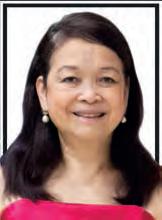
Tim Llena
Administrative Assistant Lilia Capalad
Editorial & Production Assistant Jim Bea Sampaga
Carlota Hufana Ader
Elpidio R. Estioko Perry Diaz Emil Guillermo
Melissa Martin, Ph.D.
Seneca Moraleda-Puguan J.P. Orias Pacita Saludes
Reuben S. Seguritan, Esq. Charlie Sonido, M.D. Emmanuel S. Tipon, Esq.
Clement Bautista
Edna Bautista, Ed.D. Teresita Bernales, Ed.D. Sheryll Bonilla, Esq. Rose Churma
Serafin Colmenares Jr., Ph.D. Linda Dela Cruz Carolyn Weygan-Hildebrand Amelia Jacang, M.D. Caroline Julian Raymond Ll. Liongson, Ph.D. Federico Magdalena, Ph.D. Matthew Mettias Maita Milallos
Paul Melvin Palalay, M.D. Renelaine Bontol-Pfister Seneca Moraleda-Puguan Mark Lester Ranchez
Jay Valdez, Psy.D. Glenn Wakai Amado Yoro
Philippine Correspondent: Greg Garcia
Neighbor Island Correspondents: Big Island (Hilo and Kona)
Grace LarsonDitas Udani Kauai Millicent Wellington Maui Christine Sabado
Big Island Distributors
Grace LarsonDitas Udani Kauai Distributors
Amylou Aguinaldo Nestor Aguinaldo Maui Distributors
Cecille PirosRey Piros Molokai Distributor Maria Watanabe
Oahu Distributors

Yoshimasa Kaneko Pamela Gonsalves Shalimar / Jonathan Pagulayan
Advertising / Marketing Director Chona A. Montesines-Sonido Account Executives
Carlota Hufana Ader JP Orias
022 is turning out to be a banner year for Filipino-Americans impacting Ameri can pop culture.
In August, the first-ever Hollywood big pro duction Filipino-themed and almost all-Filipino cast mov ie – Jo Koy’s Easter Sunday – was released in thousands of theaters in the U.S. and Cana da, breaking in the top 10 on its first two weeks of release.
Just two weeks ago, R’Bonney Gabriel (Miss Texas 2022) became the first Filipi no-American to win the Miss USA title. She will represent the United States at the Miss Universe pageant 2022, to be held on January 14, 2023 in New Orleans, Louisiana.
Gabriel was the first Asian American to win Miss Texas.
Gabriel, 28, of Houston, TX, is a fashion designer (cre ating eco-friendly clothing) and model. She graduated from the University of North Texas with a bachelor’s degree in fashion design and minor in fibers.
Her father is Remigio Bon zon “R. Bon” Gabriel, born in the Philippines, immigrated from Manila at the age of 25 to Washington and went on to earn his doctorate degree in psychology at the University of Southern California. Her moth er is Dana Walker from Beau mont, TX.
And we also do not agree with some who are calling for tourism to be done away with completely. That’s extreme and not beneficial for the state in so many ways. This definite ly does not serve our Filipino community, many of whom rely on tourism for work; and in some of these union jobs, they receive good pay for their skill level that will not be easily sub stituted.
Another way to look after the best interests of Hawaii is to hire the best and most quali

Any Filipino knows the significance of beauty pageants in Philippine culture. Gabri el herself said in an interview, “in the Philippines there are two national sports, boxing and beauty pageants.” And Gabriel is exactly right.
Unlike in the U.S. where there are some who question the value of beauty pageants –and rightfully so to an extent – in the Philippines they look at pageants as a way for girls to compete in a competitive world, and to learn to develop social skills, poise, and to han dle pressure. Girls in the Philip pines enter pageants ultimately for confidence-building.
And since beauty pageants are impressed upon young girls in the Philippines like a sport, as a country the Philippines is one of the best at pageants in the world. The Philippines is a power house when it comes to international pageants.
The Philippines is only behind the U.S. (eight titles) and Venezuela (seven titles) in the number of Miss Universe winners. The Philippines has won the Miss Universe crown four times: Gloria Diaz (1969), Margarita Moran (1973), Pia Wurtzbach (2015) and Catriona Gray (2018). Their contestants frequently place in the top 10 or top 5. There were also a few runner-ups.

It’s worth mentioning that the Miss Universe winners from the Philippines went on to do great charitable and profes
fied locals to run key positions in the visitors industry.
When it comes to hospi tality and knowing what our communities value, the best resource to tap is our bright and capable local work force.
Of course, this doesn’t mean that industry owners and cor porations should hire only lo cals. But the standard, what it has been for decades, is to hire nonlocals for the top positions such as General Manager to lead the biggest hotels in our state.
In this area, hiring of the top brass in tourism to include more locals, there should be
sional work after their victories, which aligns with the larger values of beauty pageants be yond just beauty.
Diaz has become a major figure in the entertainment indus try, having a fruitful career as an award-winning actress and tele vision host. She’s been involved in many charitable events.
Moran ran a few private companies. She also hosted a television series and produced movies. She is also a patron of the arts, serving as President of Ballet Philippines. Lastly, she is also known for her phil anthropic work with Habitat for Humanity Philippines and the Mindanao Commission on Women Organization.
Wurtzbach works with the Miss Universe organization, spreading awareness on HIV and AIDS. She has also begun work in show business as an ac tress and host.
Gray became the ambas sador of Philippine Red Cross during the COVID-19 pan demic. She has advocated for women’s rights, indigenous culture, and the “One Town,
One Product” (OTOP) project of the Philippines’ Department of Trade and Industry. She be came the host and performer of the TV5 variety show, Sunday Noontime Live!.
As for other international pageants, the Philippines has also won Miss Earth four times, Miss International six times, and Miss World one time.
Unfortunately, but it may be a blessing in disguise fur ther testing her character and strength, R’Bonney Gabriel Miss USA, her victory has been clouded in some controversy. Without solid evidence, a few 2022 contestants have accused the pageant organizers of fixing this 2022 results. Mainly three contestants have gone on social media criticizing the pageant organizers (not Gabriel) of se lecting Gabriel as the winner before the start of the pageant.
The unfounded accusa tions have dampened Gabriel’s win and put her on the defense. Gabriel issued a statement, “I would never want to enter a competition that was rigged. I have a lot of integrity.” She added, “I know all of the con testants worked really hard to prepare and I don’t want these allegations to overshadow the accomplishments of all the women who participated in this
year’s Miss USA competition. I know how hard every woman worked and I want their efforts to also be acknowledged. At this time, I am excited to move forward with training for Miss Universe and all of the oppor tunities that the Miss USA Or ganization will provide, while expanding on my personal plat form for sustainable fashion and advocating for charity part ners Best Buddies and Smile Train.”
There have always been rumors of insider fixing at pag eants as long as pageants exist ed. Why perhaps this is getting so much attention could be be cause of the popularity of social media where contestants with poor sportsmanship can voice their opinions. Last year’s Miss USA pageant had similar com plaints, but was not given as much media attention as this year’s.
We fully support Gabri el and will be hoping for her to have a great showing in the upcoming Miss Universe pag eant. The unfounded allega tions by a few bad apples will not take away from the Filipino community’s celebration over Gabriel’s achievement.
Mabuhay Gabriel. We’re proud of you and how you are handling yourself!
balance to changes here as well. If we are talking about the hotel industry being more responsive to and working more collabora tively with local communities as the new direction of tour ism, it’s a no-brainer that more locals, including many in our own Filipino community, ought to be considered for top man agement positions.
We wish GM Joe Ibarra much success at the Kahala Hotel & Resort. You’re an in spiration for our youth and to many in our Filipino commu nity who are currently work ing hard in our hospitality in dustry.
Before the Four Seasons Resort at Ko Olina and Aulani Disney Re sort on West Oahu, or the Turtle Bay Resort on the North Shore, there was one resort on the island of Oahu outside of Waikiki – the Kahala (formerly known as the Kahala Hilton when it opened in 1964). Today it’s called the Kahala Hotel & Resort currently owned by Resorttrust Hawaii.
The world-renowned Kahala (5000 Kaha la Ave) sits at the end of Oahu’s famous Kaha la Avenue coastline that is frequently referred to as the Beverly Hills of Hawaii. For decades the hotel had been the go-to Hawaii destina tion for royalty, dignitaries, the rich and fa mous – an exclusive hotel that is close enough to the hustle and bustle of central Honolulu, but adequately distanced away for a quiet, se cluded ambiance.
Besides tourists, the Kahala has been host to Hawaii locals for weddings, galas, corpo rate functions. It has been a favorite stayca tion for couples and families. During the peak of the COVID-19 pandemic after the Kaha la was closed briefly, it was the local clientele that kept business going at the hotel as the international and mainland tourist market came to a halt.
Joe Ibarra, General Manager (GM) of the Kahala, told the Hawaii Filipino Chronicle
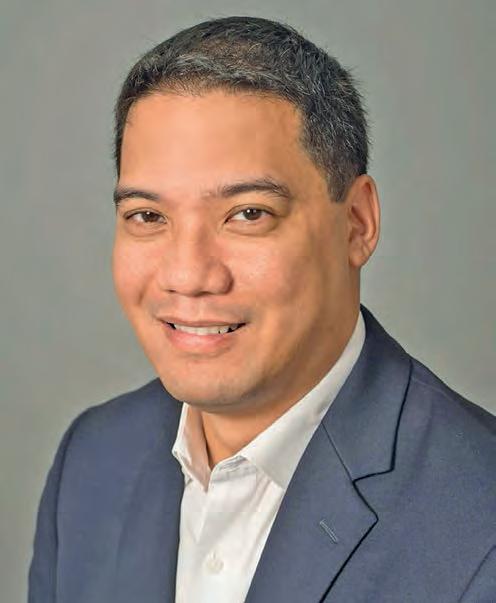
The Kahala hotel exec utive looks back at two ma jor influences in his life that steered him on his career path. The first, Joe says, was a passion instilled in him by his father Proceso Guzman Ibarra who also worked in the visitors industry. “My fa ther who came to Hawaii in his late 20s from Sinait, Ilo cos Sur, Philippines, worked at the Waikiki Beach Marriott and at his recommendation encouraged me to consider going into hospitality.” Joe said his father started work ing at the Hawaiian Regent Hotel two weeks before he was born; which he looks at
“As we navigated the pandemic in March of 2020, our resort closed for two months and with support of our ownership, despite not having domestic and international travel, we opened our doors in June of 2020 to fo cus on the local kamaaina market.
“We felt it would be our opportunity to re-introduce the Kahala to the locals. We wanted to offer the ability to experience the resort as a guest and to give them an opportunity to relax and enjoy the timeless oasis that is The Kahala.”
Joe said he saw many locals come back month after month, telling him how grateful they were to have a place where they could get away and enjoy. “We were able to build a new market segment and have since doubled our kamaaina bookings from what it was pre-pandemic” Ibarra said.
Ibarra, who took the helm of the resort in 2019, said it was a focus of his to pivot to attracting more locals to the hotel.
His efforts is paying off as the hotel re cently won the award for Hawaiiʻs Best, Best Hotel Staycation awarded by the readers of the Star Advertiser.
Attracting more locals is just one change among others that Ibarra envisions for the 338-room luxury resort.
In fact, since the pandemic, the entire tourism and hospitality industry in Hawaii
as hotels and hospitality have been part of his entire life.
“As the largest economic driver in the state [tourism] it has provided a roof over my head as a child and continues to do so as an adult, not only for me but for my entire oha na,” Joe said.
He remembers as a youth he and his family participat ed in the annual Charity Walk and many other hotel spon sored activities. Those were happy times for the Ibarras.
“The Hawaiian Regent Hotel became the Waikiki Beach Marriott in 2000, so eventually when I worked for the hotel it was like coming home to family” Joe said.
Besides the influence his father had, Joe says his
education at Kamehameha Schools Kapalama was his second career influencer, an other catalyst that sparked his passion for tourism because the Hawaiian culture, its his tory and practices he learned at the school were aspects that he wanted to share with travelers from around the world.
Before being accepted to Kamehameha Schools, Joe attended Kaiulani and Kau luwela elementary and spent one year at Central Middle School. “I grew up in Kalihi in my formative years in the low income housing project, Mayor Wright Homes.”
is changing to be more interactive, respon sive and involved in Hawaii’s community. Hotels are reaching out more to work with the local community in building sustainabili ty, preserving the environment and teaching visitors our local and Hawaiian culture.
It’s an exciting time for hotel executives like Ibarra to lead a new era of tourism in Hawaii. As the first non-Caucasian, and first Filipino-Hawaiian ancestry GM at the Ka hala, Ibarra enriches the leadership pool in Hawaii’s tourism industry that is on its way, some believe, to becoming more pono (prop er) and aligned with the values of Hawaii’s local community. It’s no longer just about maximizing tourist numbers, but also about building quality tourism.
His father worked multi ple jobs, in addition to his ho tel job. His mother, Violette Mahealani Ah Nee Ibarra, worked for the State of Ha waii Transportation Depart ment in various divisions.
Like many Filipino fam ilies in Hawaii, Joe’s father was able to immigrate to the islands because a family member who worked in the sugar plantations sponsored him. That support came from his great uncle Apo Ibarra, Joe mentions with a deep sense of gratitude.
His mother’s family hails from Kapaa, Kauai, but they moved to Oahu when Violette was in elementary school.
“My father being a first generation immigrant meant
that our lives were inherently tough.
Our family lived pay check to paycheck, as many families here do, but we al ways had a roof over our head and food on the table.
“To make ends meet both my parents went to work and my brother, sister and I became latch key children,” Joe said. “We learned independence, and I learned how to cook for a family of five on a budget.”
Joe and his siblings would soon get some help while his parents worked. “My fa ther was able to save enough money and thankfully able to bring both his parents from Sinait, Ilocos Sur to Hawaii.
“My grandparents went
to work but were also able to take care of us. Some of my fondest memories are of spending time with my grandmother in her room learning about all my cous ins in the Philippines, their names, ages, and hobbies.
Eventually Joe would meet his relatives in the Phil ippines as a young adult. “I felt like I knew everything about them due to her stories.”
On growing up Filipino, Joe said he is particularly fond of Filipino food and the Filipino people’s hospitality.
“I love Filipino food. There is nothing like my fa therʻs cooking. It is amazing to have my father be able to cook all my favorite foods. His specialty is his pork gui santes. Although we have many Filipino food options here in Hawaii, no one can du plicate the flavor and taste that comes with my dad’s cooking. It has to be the love he adds as his secret ingredient.”
Yes, love as the magical ingredient that lifts cuisine to another level, like in the film Like Water for Chocolate.
Joe speaks often about his father who he considers his role model. “At a young
age I knew that my father worked so hard to provide for us. Although he worked several jobs, on his days off, he made sure that at least one day a month he would take us to the beach, or when in town, the 50th State Farm Fair or other event.
“Before he left for work on the weekends he would give my brother, sister, and I each one dollar so we could buy a snack from the manapua man who came to the housing projects each day. One dollar at that time could get us a drink and a candy bar, and as a child that was everything. It’s those lit tle things I remember fondly, and I am so blessed to have him in my life.”
On Filipino hospitality, he said “There is a reason so many of us are in tourism and
hospitality. As a people we are generous and genuinely want to share what we have with everyone. And generally we all love food.
“You can never go to a Filipino household without being asked to have a meal. Then after the meal, we must have the after meal snack (me rienda). It is through breaking bread with someone that you truly get to know them and build lasting friendships.”
Home life was stable and secure enough that afford ed Joe the discipline, even as a latch key teen, to study hard. After graduating from Kamehameha with honors, he accomplished what many high school graduates only dreamed of – to attend a pres tigious Ivy League School.
“It does not matter how much or how little money you have. All that matters is that you work hard, focus on what’s right in front of you and take small steps that build toward larger goals. Going back to the province of Sinait with my father, I finally understood where he came from. I understood the opportunities right in front of me and I then knew how blessed I was to call Hawaii home. I worked even harder, knowing that my mission was to make my family’s life just a little bit better than I had when I grew up, know ing the sacrifices of the past leads to success in the future. With hard work and persever ance your dreams can come true.”
Joe Ibarra, GM, The Kahala Hotel & ResortJoe headed to the presti gious Princeton University in New Jersey where he said it was a period of tremendous growth. “I had never left Ha waii then, besides going to the Philippines for six months when I was two years old with my father. I was 17 years old, very naïve to the world and at tending an Ivy league school all the way on the East Coast forced me to grow quickly as an adult.”
Like many locals who go off to study in the mainland, Joe found himself comparing Hawaii customs to mainland customs. But unlike the West Coast that draws abundant
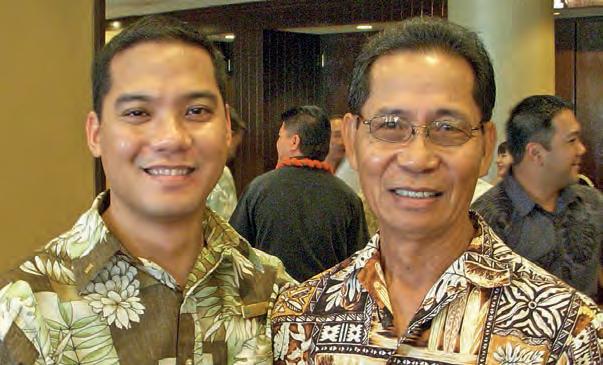 Flora Galla LaMontagne, Director of Guest Relations
Flora Galla LaMontagne, Director of Guest Relations
guests that come through the Resort’s doors.
LaMontagne is the point of contact for VVIP guests and she coordinates and works with the various departments at the Kahala to “fulfill the preferences of these VVIPs,” she said. Her work also in cludes maintaining continued relations with these guests.
for me. I have met and created long-lasting relationships with people from all over the world. I find a lot of satisfaction in calming a guest and finding solutions to the challenges posed by our guests.”
BA in Literature, 2 final cours es shy of BS in TIM. Started Masters in Asian Studies with a focus on Burma.
similarities to Hawaii, the East Coast is quite foreign to the typical Hawaii teen-young adult. “In Hawaii, we are sur rounded with many different people and cultures, but being on the East Coast I was able to further broaden my ex posure to other cultures and ways of thinking.” He said at Princeton he also was able to enhance his critical thinking skills and learned about social challenges that exist in other parts of the world.”
In an environment that’s academically competitive, and more so, among the crème dela crème at Princeton, Joe
(continue on page 5)
LaMontagne has been working at the Kahala Hotel & Resort for over 14 years. As Director of Guest Relations, she takes care of VVIP guests, prior, during and after their stay at the hotel. Some of her VVIP guests include artists, govern ment officials, foreign digni taries, royalty and CEOs. She says, basically, all high-profile
Prior to the Kahala Ho tel and Resort, Flora worked at the Sheraton Waikiki Hotel for 10 years. She started as a Front Desk Clerk and worked her way up to Assistant Front Office Manager.
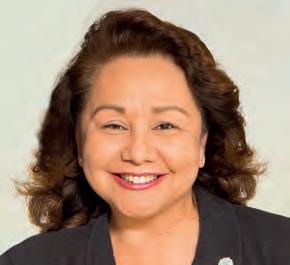
Her inspiration to make a career in the hotel indus try: “I found the hospitality industry fascinating, the tran sient nature of the industry and meeting guests from all over the world made it so fulfilling
What makes the Kahala special? “The Aloha spirit of our staff really shines through. Many [here] have been work ing for decades and our guests (who have become a part of our Kahala ‘ohana) who return year after year often comment on how it feels like home. Of course, the location also puts our guests, especially our ka maaina, in a totally different environment. Our kamaaina can experience a level of ser vice and feel that our offshore guests experience.”
Educational back ground: B.Ed, BA in History,
Place of origin: Flora was born and partly raised in the Philippines before migrating to the U.S.
On working with GM Joe Ibarra: “I’ve had a real ly great opportunity to work closely and continue to do so with Joe Ibarra prior to his be coming the General Manager of The Kahala as he was my immediate director when he first arrived at The Kahala.
His transparency, tempera ment, wealth of knowledge (of the hospitality industry) and willingness to listen to everyone (from management team to working line staff) makes his leadership work well under all circumstances.”
Alcantara has been work ing at the Kahala Hotel and Resort for close to 12 years. He’s fairly new to his current position as Director of Pur chasing and Cost Control (just over a year). Prior to that, he was the Director of House keeping for 10.5 years.
His career in the hospitali ty industry spans more than 25 years, taking on various roles as Service Express Manager, Front Office Manager, Direc tor of Housekeeping, Director (continue on page 6)
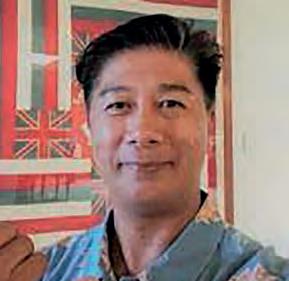
said, “Every person I met was engaged, ready to learn, and in one way or another, each of us wanted to ‘save the world’ in our own way.
“Although opportunities arose to grow on the main land, I learned how important it would be for me to return to Hawaii and help our island home,” Joe said.
“To help our island home” – remember that, because this goal was not just an empty goal, but something the young Ibarra back then, is realizing at this moment as the fully grown adult Ibarra. (More on that lat er.)
After Princeton, Joe re mained humble and knew he had to pay his dues and work his way up the hospitality in dustry. His first position was as a phone operator for the Waiki ki Beach Marriott. To some, it may seem unfitting for an Ivy League graduate. But pride would not stand in the way for this future GM.
His many line positions after his first gig as a phone operator would give him valu able insight into every aspect of the hospitality industry. Not to mention, the respect from coworkers and colleagues knowing that he started at en try-level.
Four years into his new career he became Front Of fice Supervisor at the Waikiki
Beach Marriot Resort and Spa. Within a year, he was Front Desk Manager. With manage ment experience under his belt, he landed a Reception Manag er position at another hotel, the Waikiki EDITION Hotel, Eight years into his career, Joe got hired at The JW Mar riott Ihilani Resort & Spa, Ko Olina (today it’s the Four Sea sons Resort) where he held two management positions within a four-year period: Catering & Conference Services Manager (Events Manager) and Front Office Manager. It was a big break of sorts and a sign that he was on the right path.
In 2014, he made it to the Kahala Hotel & Resort where he held various positions prior to becoming GM: Director of Front Office Operations, Di rector of Rooms, and Resort Manager.
Now at the pinnacle of the hotel industry as GM in a tourism market (Hawaii) that rivals the best tourism cities in the world, and in a world-re nowned hotel in the Kahala, Ibarra finds himself in the po sition to accomplish what he intended after graduating from Princeton, “to help our island home.”
Internally at the resort, Joe oversees all aspects of hotel operations from housekeep ing, engineering, security, front office operations, spa, the six food and beverage outlets, Room Dining and Banquet and Catering operation.
He also focuses on revenue generation, sales, marketing and PR within the community and provide direct support and oversight with the ownership company.
rection of the tourism industry in the state.
Ibarra was invited to be a part of the Hawaii Tourism Au thority’s (HTA) steering com mittee for the island of Oahu Destination Management Action Plan (DMAP). The initiative brought leaders to gether offering different views of tourism, its impacts, and to come up with an action plan to improve the industry. That, in effect, touches the livelihoods of tens of thousands of Hawaii workers and businesses, as well as the state treasury.
He explains, “Many peo ple do not understand that tour ism is not limited to Waikiki or hotels. Tourism is linked to in dependent restaurants, tour op erators, food suppliers, trans portation companies, farmers, and many other things.
“Over 250,000 people on Oʻahu are connected or know someone whose job is linked to the industry. It also generates billions of dollars in tax rev enue [over years] which sup ports government programs which we all benefit from.”
A prescription for improv ing the visitors industry, he said “if we want the tourism industry to continue to thrive, we must do a better job of building community engage ment, getting community in put, and thinking of how tour ism impacts the different areas of our island.
is my belief that The Kahala can lead the way.
“Here at The Kahala we have done a few items to help educate our visitors, and I am hopeful that other resorts and brands that do business in the islands also consider imple menting these items,” Ibarra said.
Two projects at the Kaha la:
1) Pono Guest Video. Ibar ra created an education al video that’s shown to guests teaching them their pono (proper) actions as responsible guests, to ensure they can help to maintain the beauty of the island. “Guests learn how one small action can have larger impacts and that we ask them to join us on our mission of keeping our is land home pristine,” Ibar ra said.
2) KISCA program (Kahalaʻs Initiative for Sustainabil ity, Culture and the Arts). Guests can donate (option al) a daily fee during their stay which helps support sustainability, environ mental, cultural preserva tion, and arts in Hawaii.
Besides the Kahala em ployees and their families that Ibarra’s work directly impacts, as GM for a major hotel as Ka hala he is empowered to im pact communities and the di
“As the head of the larg est private business in Waia lae-Kahala, I can be an exam ple of how we can pivot and put these DMAP action items into practice. This is some thing that everyone needs to be committed to in order to allow us to affect real change, and it
“We offer a myriad of ac tivities for our guests to par ticipate in. These activities are open to the public as we are committed to educating and sharing this knowledge with all and not just those who are staying in the resort.
“I created a video to help share this program with our guests and community. The program helps us toward re forestation as we support the growth of the Kahala legacy
(continue on page 8)
of Operation, Assistant Gener al Manager and Acting GM for various hotels in Portland, Or egon and Seattle, Washington.
His inspiration to make a career in the hotel indus try: “Because I want people from other parts of the world to come to a place they had never visited and provide them hospitality, to learn our culture and offer a heartfelt genuine ALOHA! I find per sonal fulfillment when a guest can take home with them an
experience, a memory that lasts them a lifetime because of their visit to The Kahala; also giving my associates the tools they need to succeed to do their job that much easier and that much better.

What makes the Kahala special? “The genuine hospi tality that you get from every individual employee!”
Educational back ground: Lanai High School and Portland State University Place of origin: Born in

Aiea, Oahu, Hawaii; but grew up mostly on the island of La nai, Hawaii
On working with GM Joe Ibarra: “I have worked with Joe Ibarra or “Joey” for over eight years! He brings with him a vision, a vison of authentic hospitality. He de livers his vison from the heart and ensures that everyone is on the same page so that we can delight our guests and ensure they had a great experience and a great time at our Kahala!”
“Helping our island home”his post-Princeton goal coming to fruition
In last issue’s Part I, we quoted for mer Philippine President Fer dinand E. Mar cos’ declaration “I was kidnapped.” We cited the corroborative statement of Eduardo “Danding” Cojuang co who was kidnapped with him.
Brigadier General Santi ago Barangan, my cousin-inlaw, who was Marcos’ Chief of the Presidential Security Command, told me that Mar cos’ plan during EDSA was to travel to Ilocos Norte by land. They had loaded trucks with money to finance the contin ued operation of the govern ment.
When the EDSA demon strators against Marcos were gaining ground, I called For mer Senator Leonardo B. Pe rez, a close friend of Marcos, and my fraternity brother in the Alpha Phi Beta Fraternity.
I told him that the Consul General in San Francisco be came a “balimbing” (multisid ed fruit or “turncoat”) and had joined Cory Aquino.
“I will tell Marcos to ap point you as officer-in-charge,” Perez said. “I can’t accept brod, I am a U.S. citizen,” I replied.

“What’s the plan of Mar cos if the rebels get closer to Malacanang?” I asked. “We will go to Ilocos Norte and continue running the govern ment from there,” Perez said.
The “Malacanang of the North” was built by Marcos on the shores of Paoay Lake near Laoag.
“Can Marcos hold the fort if Cory’s forces attacked?” I asked. Perez said yes, as long as the Americans do not inter fere.
“What if the Americans interfered,” I asked. Marcos might ask other countries for
help, said Perez. “Like Rus sia?” I asked. He did not an swer.
People believed that the Americans had begun to dis like Marcos because he was playing the “Russian card”.
Fernando del Mundo’s article in UPI on August 8, 1985 said: “President Ferdi nand Marcos, apparently play ing his ‘Russian card,’ chided the United States Thursday for interfering in Philippine affairs and accepted a cere monial award from the Soviet Union… The 67-year-old lead er has sharply attacked moves by the U.S. Congress in recent months to attach conditions to U.S. aid to the Philippines, saying such efforts constituted interference in the Philippines’ internal affairs.”
Citing former Sen. Rene Espina, the article said: “Mar cos is sending a signal to the United States that if they don’t like him any more, the Rus sians will be very happy with him.”
Imelda Marcos met with the Soviet Ambassador to the Philippines and raised a toast to Soviet-Philippine friendship on Soviet National Day after returning from a trip to the So viet Union, wrote Seth Mydans in the New York Times, No vember 8, 1985.

Imelda announced that ties between the two nations have entered “a new era of friend ship and mutual cooperation.” Mydans said that political commentators had pointed out that Imelda’s trip was made to play the “Soviet card” against the Americans.
It has been said that “to err is human, to forgive divine.”
But the kidnapping of Marcos was not an error. It was a delib
erate wrongful act - whether it was done at the behest of Cory, or because the Americans did not like Marcos anymore for playing the “Russian card”, or for whatever reason.
I visited Marcos at his temporary residence on Kala nianaole Highway in Honolu lu after he was released from Hickam Air Force Base. I ex pressed my sorrow for the pain he must be suffering after the way he was treated.
He replied: “You don’t have to be sorry, you had noth ing to do with it. There will be retribution.”
“How do you feel about Enrile?” I inquired. “Do you know Enrile?” Marcos asked. “Yes,” I replied. “I was Cor porate Counsel of Dole Cor poration and his firm was the retained counsel. We met a number of times. He is intelli gent.”
“Have you heard of the Enrile breakfast?” Marcos in quired. “No, sir,” I answered. “An Enrile breakfast consists of two soft boiled eggs and one small chorizo,” Marcos said, laughing de risively.
I said: “Per haps, if you had appointed Ramos as Chief of Staff he would not have joined En rile.”
“How can I appoint him, he is like a “wheel barrow?” Marcos retorted. I asked what he meant.
“Don’t you know what a wheelbar row is? You must
theory is that Marcos, Jr. wants to keep a close eye on Enrile to prevent him from committing mischief.
Marcos Jr. must be a fol lower of Sun Tzu, a Chinese military strategist, who said in The Art of War that one should “keep a close watch on the en emy.”
lift it and push it to make it move.”
As for Marcos Jr., how does he feel about the kidnappers? People say that by coming to America to address the Unit ed Nations General Assembly and by meeting with President Biden, he has forgiven the kid nappers. Coming to America does not show forgiveness.
Marcos Jr. already came to Hawaii after he had returned to the Philippines. I introduced him when he spoke before the Filipino community. While in Hawaii, he was asked to appear before a U.S. District Judge. We were barred from entering the courtroom.
People say that Marcos Jr. is a forgiving person citing his appointment of 98-year-old Juan Ponce Enrile as Chief Presidential Legal Counsel. According to observers, if not for the Enrile “coup d’etat” there would have been no kid napping.
That’s not necessarily ev idence of forgiveness. There are two theories on why Mar cos, Jr. appointed Enrile: One
The other theory is that if Marcos Jr. wants to declare martial law, Enrile’s prior mar tial law experience under Mar cos Sr. will come in handy.
September 11, 2022 is the 105th anniversary of the birth of Ferdinand Marcos. I was in his hometown of Sarrat during his 100th birth anniversary in 2017.
We first met Manong Andy (that’s how we addressed him) in 1947 in the home of my un cle Dr. Damaso T. Samonte, then congressman of the first district of Ilocos Norte and chairman of the Liberal Party of the province. Marcos want ed to run as congressman of the second district.
When Roque Ablan, Jr. and I were studying at the Uni versity of the Philippines, and Manong Andy was already a congressman, we would bor row his Chrysler. We drove Manong Andy’s girlfriend Miss Press Photography of 1949 Carmen Ortega wherev er she wanted to go.
Manong Andy was the first to offer me a job in his
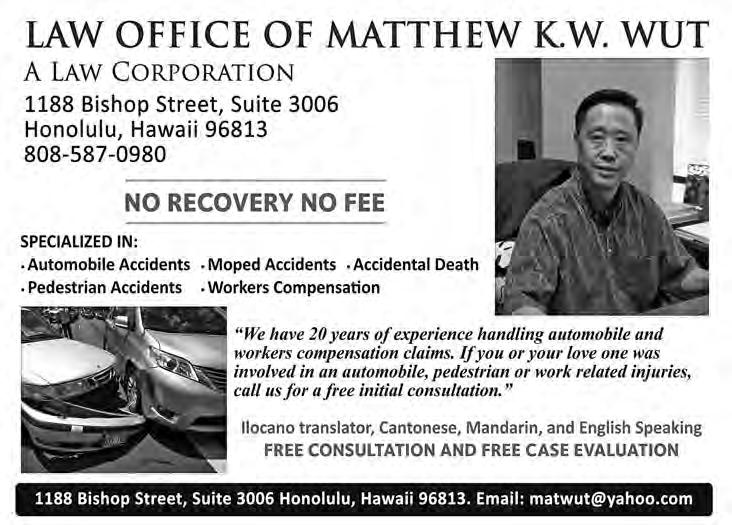
This October marks the coin cidence of the new Supreme Court session, the Filipino American History Month, and the opening of a new satirical history of race in America by the esteemed African Ameri can writer Ishmael Reed.
Let’s start with the Su preme Court. No matter how much we hail and praise Judge Ketanji Brown Jack son’s arrival, the first African American woman to serve on the court will not be able to mitigate the foulness we are about to experience.
Affirmative action, gay rights, abortion rights, voting rights, we are almost certainly assured that the hits will keep on coming.
But if you think it’s bad now, you should have seen SCOTUS in 1857.
That’s when the high court rendered by a 7-2 vote what
forest on the North Shore. Reforestation is one of the best ways to mitigate carbon impacts in our atmosphere,” Ibarra said.
KISCA provides cultural activities, and a monthly sem inar where leaders in sustain ability can come to the resort to share their work and edu cate the public and our guests on initiatives that support cul ture and the environment.
“If we do not preserve our home, the island we know and love now will not exist in the future,” Ibarra said.
Specific to the Resort’s neighborhood community – Joe said, “My goal is that the Kahala be an active par ticipant in our community. He said the Kahala currently engages with the communi ty boards, the organizations surrounding the resort and non-profit organizations in
some have called the worst SCOTUS decision ever, the Dred Scott opinion, written by Chief Justice Roger Taney.
Most people know of the case from history, if history hasn’t been banned from your school yet (if you’re young).
Or if the history has been total ly forgotten (if you’re older). I dread if you stop any Ameri can today at random and ask about Dred Scott, you might hear something vague like, “It’s about slavery, right?”
To refresh, the case in volved Scott, a slave who had been allowed to move from Missouri to a free state (Illi nois), but then sued his owner for his freedom in Missouri.
Taney’s majority opinion ruled for Scott’s owner pri marily because African Amer icans couldn’t be citizens, and that Congress couldn’t prohibit slavery in new U.S. territories like Missouri in the first place.
More startling was the finding that people of African
Maunalua Bay such as Mala ma Maunalua and Maunalua Fishpond Heritage Center.
“The Kahala has been a pillar in the Waialae-Kahala community for over 50 years. As the largest private business within this area, I feel it is my kuleana (responsibility) to ensure that the resort plays a role in enhancing the quality of life of our employees and community in the area.
“There is so much great work being done on the fore fronts of sustainability, cul tural preservation, and envi ronmentalism. I turned to the Hawaiian land management system (ahupuaa) as guide for the Kahala to partner in recip rocal relationships in our area from mauka (the mountain) to makai (the ocean).”
As a business and com munity leader, Ibarra’s mes sage to Hawaii’s youth: “It
ancestry had, to quote Taney, “no rights which the white man was bound to respect.”
Whites were simply seen as superior. So, what does this have to do with Filipino American History Month?
Chief Justice Taney based his terrible Dred Scott opin ion on an 1840 case in which Taney himself wrote the opin ion regarding one Lorenzo Dow.
Dow was a Filipino-born sailor on an American ship, who had been accused of mur der and tried in Maryland.
In the U.S. v. Dow deci sion, Taney used for the first time the notion that whites were a master race (“the race of which the masters were composed”). That was the proof of superiority since only those of European back grounds could be part of po litical society in the colonies. Therefore, the only question Taney saw as significant was whether Dow was a person who had any rights at all,
does not matter how much or how little money you have. All that matters is that you work hard, focus on what’s right in front of you and take small steps that build toward larger goals.”
He said the life his father and mother provided for him was better than the life they had growing up and that he is so grateful for that.
“Going back to the prov ince of Sinait with my father, I finally understood where he came from. I understood the opportunities right in front of me and I then knew how blessed I was to call Hawaii home. I worked even hard er, knowing that my mission was to make my family’s life just a little bit better than I had when I grew up, know ing the sacrifices of the past leads to success in the future. With hard work and perse verance your dreams can come true.”
meaning “a white Christian person.”
He was not, and Dow’s conviction of murder was up held.
Seventeen years later, Taney used the Filipino Dow to reason that non-white, or essentially all people of color, could be reduced to slavery for the white man’s benefit.
It wasn’t an African Amer ican, or a Native American. It was a Filipino in America who was at the heart of what is arguably the worst Supreme Court decision ever.
More than a footnote, the unheralded Dow should be seen as a foundational build ing block of America’s racist history.
All those “inalienable rights” under the Constitution were indeed whites only and did not include any people of color. Including Filipinos.
Ponder that as you wish people a happy Filipino American History Month.
As Dow proves, it’s not just for Filipino Americans.
It is a history for all peo ple of color in America.
This month, I will again be telling stories of the first Filipinos to arrive in the U.S. in 1587. As well as the tales of Filipinos like my dad who skipped Hawaii and went straight from Ilocos to San Francisco. Or of Fil-Am unionist Larry Itliong who merged civil rights and labor rights when he started the Delano Grape Strike of 1965.
And that’s just a small part of Filipino American history.
But Filipino American history is also personal his tory. This month, I honor the noted African American nov elist, essayist, poet and play wright Ishmael Reed.
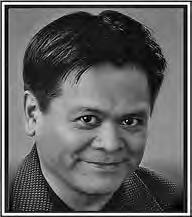
When I was in graduate school at Wash U. in St. Lou is, I wanted to be a funny nov elist like Philip Roth. But my professors said I had too many Filipino characters and should take them out.
Reed, a visiting writer from Oakland, told me to put the Filipinos back in.
No one told me that. But Reed did.
This week, New York’s Theater for the New City presents a reading of Reed new play, “The Conductor.”
Reed’s satirical view of America’s race situation tar gets the recent recalls of pro gressive politicians in San Francisco led by conservative Asian Americans.
Reed provides a twist, a fictive Indian prime minister who creates an international scene that forces Indians to flee the U.S.
That includes Shashi Par mar, one of the Indians who led the recall effort.
Parmar, on the run, seeks help from a new “under ground railroad” to get to Canada. And the conductor? It’s a character named Warren Chipp, a columnist who was fired for speaking out against the recall.
As Chipp and Parmar en gage and debate, you’ll learn a lot about everything from Asian American history to Af rican American history to the current status of Dalit women in India.
Provocative? Of course. The “N” word is used—about Asians.
The virtual reading means you can check in from any where, Oct. 13 to 16.
I have a very small part as a Fox News-type commenta tor. Think Tucker Carlson in brownface.
But “The Conductor” is all Reed, and his vision of how people of color have been mistreated historically in America. In a theatrical read ing, that vision comes through loud and clear.
EMIL GUILLERMO is a jour nalist and commentator. He writes a column for the Inquirer’s North American Bureau. He talks about this column and other matters on “Emil Amok’s Takeout,” my mi cro-talk show. Live @2p Pacific. Livestream on Facebook; my You Tube channel; and Twitter. Catch the recordings on www.amok.com.
Hawaii has the highest level of government reg ulation related to homebuilding in the country. It also has the highest average home prices in the nation. This is not a coincidence.

Multiple studies have es tablished that high home pric es are strongly correlated with such regulations, including land-use and zoning laws and multiple layers of approvals and permissions.
A recent report from the University of Hawaii Eco nomic Research Organization revealed that Hawaii’s score on an index measuring gov ernment barriers to housing is the highest in our country — and not by a narrow margin. Even regulation-heavy locales like California and New Jersey score lower than Hawaii.
Given that 1 point on the index correlates to an 8% in crease in the price of housing, it’s obvious that the best way to bring down housing costs is to reduce government in volvement. Unfortunately, some politicians continue to believe that more government programs will “solve” the lack of affordable housing instead.
For example, Maui offi cials have been considering a bill that would cap the price of an affordable housing unit at a level even lower than it is now. It would do so by insisting that all costs associated with a pur chase — such as mortgage, in surance, taxes and homeowner association fees — fit with in 31% of the buyer’s gross household income.
So-called affordable homes already must be sold at below the market rate, but this bill would reduce the price by an additional 20% to 22%, which would virtually
wipe out any profit for home builders.
Joe Kent, my colleague at the Grassroot Institute of Hawaii, testified that the bill would discourage home builders from participating in affordable housing projects at all — or if they did, they would have to offset their losses by increasing the pric es of their market-rate homes, which already are quite high.
In response to these criti cisms, the Council’s housing committee reconsidered the bill. But instead of eliminat ing the flaws, or even shelving it completely, it brought the bill back before the full Coun cil with an additional propos al: tax-financed subsidies for either the homebuilders or the homebuyers.
That’s right. The full Coun cil now is considering leaning on Maui taxpayers to pay for a proposal that would do noth ing to improve the county’s homebuilding environment, but instead, only make it more
complicated and costly.
Clearly, the Council should be asking some point ed questions, like: Can we af ford this? If so, for how long? Do we have the infrastructure to administer a massive subsi dy program? Will we be able to guarantee that unintended recipients cannot take advan tage of the program?
Also, would subsidies for homebuilders be high enough to overcome the losses caused by the price cap? Would sub sidies increase if inflation and other factors were to drive up the cost of homebuilding? And, most important, would the county have to raise tax es to cover the subsidies for builders and buyers?
My guess is that the an swers are not what the propo nents of the bill would like to hear.
But if not more regula tions and taxes, then what?
Well, there are many things that Maui County could do to lower the cost of building
homes, and Kent listed some of those options for the Coun cil, too. Streamlining the ap proval process and loosening zoning restrictions would be a good start. What’s more — such reforms would not cost the county money, require new personnel or involve any new regulations or taxes.
The point is, whether on Maui or at the Capitol in Ho nolulu, lawmakers in Hawaii need to realize the simple truth that Hawaii home prices are high because we don’t have enough houses. And if they want to make sure that more houses are built, the most ef ficient, least complicated, least expensive way to do it is to re move Hawaii’s many barriers to homebuilding.
As the great French econ omist Frédéric Bastiat (18011850) once said: “We have tried so many things; when shall we try the simplest of all: freedom?”
KELI‘I AKINA is president and CEO of the Grassroot Institute of Hawaii.



When Ukraine bounced back to re gain terri tories oc cupied by Russian troops, their troops in the war zone didn’t see it coming!
They must have been very busy celebrating their victo ries in occupying some cities previously seized by them that they were caught flat-footed and blinded by Ukraine show ing superb military tactics and exhibiting renewed strength that pushed them back.
As the war progresses, Ukrainian children went back to school on September 1. On their first day of school, how ever, instead of sharing their fun vacations, as we used
to do whenever we go back to school, they shared their survival stories they went through with their families, relatives, and friends.
They are aware that the Sword of Damocles is hanging above their heads and at any time, could fall and hit their schools. Their stories were of surviving the war. Their first day of school was not normal. It was full of suspense and negative feelings even if the students still had the luxury of playing on campus which they have been missing.
The Associated Press reported that at least 379 children have been killed since the war began, while the whereabouts of 223 oth ers are unknown. Moreover, 7,013 children were among the Ukrainians forcibly trans ferred to Russia from Rus sian-occupied areas.
Despite the risk, 51% of schools in Ukraine reopened
to in-person classes, with an option to study online if the parents prefer.

First grade teacher Olga Malyovana told Associated Press: “This year is different from the others. We are in a war situation. We were real ly worried about the children and their safety, but we fixed all the facilities, we have a shelter.”
“Safety remains the prior ity” said the school adminis trators and national officials. For schools that don’t have access to shelters or are locat ed close to the borders or near active military zones, children will only study online.

“Two years of Covid and … six months of war, is hav ing disastrous impact on chil dren’s growth and learning and mental health,” Murat Sa hin, UNICEF representative in Ukraine said. “So, we need to bring that normalcy.”
This happened as the Rus
sia-Ukraine war is entering its seventh month of hostilities Ukraine showed superb mil itary aggression in regaining some cities originally con trolled by Russia.
But, will Russia cave in? Instead of caving in, Rus sia seems to be employing the military tactic “one step backward, two steps forward” strategy as Russia’s presi dent Vladimir Putin ordered a massive offensive and the possible use of nuclear weap ons. U.S. President Joe Biden privately warned Putin not to use nuclear weapons but will Putin heed Biden’s call?
At home, Russian citizens are revolting against Putin’s order drafting all able-bodied Russian citizens to join their army. This must be a sign that the regular Russian army is crumbling and disintegrating. But this did not move Putin. Instead, he ordered additional troops to Ukraine and vowed
to use nuclear weapons.
So, As I See It, I don’t think the renewed vigor being displayed by Ukraine forces pushing the Russian soldiers backward, is ending the war. Russia is not conceding and in fact trying to regroup and buying their time to strike back, yet again!
Ukraine’s counteroffen sive literally turned the tide and changed the dynamics of the war. Ukraine’s sudden vic tories served as good morale boosters in Ukraine-occupied areas - and in the western cap itals supporting Kyiv.
As to when it will end? Honestly, I don’t know! For as long as Russia continue to believe that as a superpower, it will not bow to a smaller country such as Ukraine, the war continues.
The thing is, Russia’s President Vladimir Putin will not pull out his troops just like that! He will continue to fight and bully smaller nations. His bloated ego and superpow
The Grassroot Institute of Hawaii has launched a petition urging the Hawaii Legislature to exempt medical services from the state’s general excise tax. The purpose is to make healthcare more affordable and help alle viate Hawaii’s doctor shortage.
“Hawaii families have been struggling with the rising costs of goods for years, and health care is no different,” said Keli‘i Akina, Institute president and CEO. “We have an ongoing doctor shortage, overstressed hospitals and delays in access to care. A GET exemption would cut costs for consumers and make Hawaii a more attractive place for doctors to practice.”
Physicians themselves have cited Hawaii’s tax on medical services as a contrib uting factor in their decisions to leave the state. Hawaii is one of only four states that taxes medical services, and doctors are unable to pass on the tax to Medicare patients, who make up about 18% of residents who have health insurance.
A GET exemption has broad support among current and prospective future state lawmakers. Candidates ranging from Democratic Lt. Gov. Josh Green to long-time Republi can state representative Gene Ward have expressed support.
er mentality are fixed in his mind that no amount of defeat in the Ukraine-Russia war zone at this time will change that.
He is committed to de stroying Ukraine and will be fighting back like a wounded animal that when pushed or cornered becomes desperate ly more forceful and energetic in offensively and defensively engaging the war to the very end.
Will the Sword of Damo cles in schools and occupied territories fall? When?
ELPIDIO R. ESTIOKO was a veteran journalist in the Philippines and a multi-awarded journalist here in the US. For feedbacks, com ments… please email the author at estiokoelpidio@gmail.com.
In addition, a bipartisan group of state senators introduced a bill in 2021 that would’ve ex empted medical services from the GET, along with food and hygiene products.
According to a survey con ducted last year by Anthology Research, 79% of residents agreed that lower taxes would help residents afford the state’s high cost of living, and 73% agreed that residents and busi nesses are overtaxed.
Akina said other factors contributing to Hawaii’s unaf fordability and healthcare short
ages include the state’s medical certificate-of-need laws, oc cupational licensing laws and “scope of practice” limits on nurses and pharmacists.
“But exempting medical services from the GET,” he said, “would be a major first step to ward providing long overdue and much-needed relief.”
The petition to exempt medical services from the state GET will be available for sig natures until January, when it will be submitted to members of the 2023 Legislature for consideration.
TheWaipahu Community Association is hosting the 16th Annual Taste of Waipahu on November 5 from 4 to 9pm at August Ahrens Elementary School on Waipahu Street.
The event will showcase food trucks, food tents, products and services vendors from some of the commu nity’s best food and business operators. Live entertain ment and keiki games are also part of the program event.
Taste of Waipahu is still accepting interested ven dors to join the event. Contact the Waipahu Community Association at (808) 677-6939 for more information.
The event is sponsored by Hawaiian Electric, Queen’s Medical Center-West Oahu, Kamehameha Schools, Nomi Health, Alexander & Baldwin and Bayer and Matanuska Valley Federal Credit Union.
For updates, follow Taste of Waipahu on Instagram at @tasteofwaipahu.

Most Filipinos are famil iar with the iconic image of Douglas MacArthur as he waded into the island of Leyte to fulfill the prom ise he made during the re treat of the American forces from the Philippines during the early stages of WWII.
“I shall return,” he prom ised, and he did, becoming the hero that liberated the Philippines and rebuilt Japan.
In April 1930, MacAr thur was the Commander of the Philippine Department of the U.S. Army, whose mis sion was to defend the Phil ippine Islands and train the Philippine Army.
He was in his 50s, di vorced and considered one of the most powerful persons back then, when the Philip
pines was an American col ony. He was also romanti cally obsessed with a young aspiring actress, a mestiza of Scottish-Chinese-Filipino ancestry named Isabel Rosa rio Cooper.

By November of that year, MacArthur was ap pointed the U.S. Army chief of staff, becoming the youngest four-star general of the US, eventually mov ing back to Washington D.C.—and persuading Is abel to join him in America without marrying her.
After four years of be ing MacArthur’s mistress, the relationship ended. To prevent a political scandal, MacArthur left Isabel. He moved on to become the U.S. military adviser to the Philippines during the prewar years, eventually be coming the first Supreme Commander for the Allied Powers and a WWII hero.
Isabel Rosario Cooper’s fate was more tragic. Al though both parties in the relationship broke many taboos during that era— MacArthur risked his career to have that liaison with Isa bel—it was Isabel who paid the price.

When the relationship ended, Isabel could not find enough courage to return to Manila, moving to Los An
geles instead, getting married and divorced twice, eventual ly meeting a tragic death. This fictional account of MacArthur’s love affair with Isabel Rosario Cooper was based on available data and books on MacArthur’s well-documented life, which always mentions this affair.
But very little was writ ten about Isabel, and what ever was written about her were noted in the footnotes. Thus, the author, Cindy Fazzi, calls her “the Fili pino girl in the MacArthur footnotes,” and this is her at tempt to shine a light on this Filipina “who, against all odds, was not afraid to live the life she wanted.”
MacArthur was gener ally seen as the Philippines’ liberator, a WWII hero. Oth ers view him as an opportun ist who used the Philippines to advance his career. He is probably a bit of both.
This book evokes the complicated relationship MacArthur had with the Phil ippines, and to some degree reflects the complex and con flicting links of the Philippines with its former colonizer.

Cindy Fazzi is a Fili pino-American writer who has worked as a journalist in the Philippines, Taiwan, and the United States. A former Associated Press reporter, this book is her literary de but. She also writes romance novels under a pen name and is soon to release a mys tery thriller novel. She also writes short stories that have been published in various literary publications.
ROSE CRUZ CHURMA estab lished a career in architecture 40 years ago, specializing in judicial facilities planning. As a retired ar chitect, she now has the time to do the things she always wanted to do: read books and write about them, as well as encourage others to write.
The changing of seasons from summer to au tumn always bring about a wonderful transformation that makes my heart light and warm –leaves are starting to fall, cool breeze is blowing, and the vivid greens of summer give way to the reds, oranges and yellows of autumn. But how does this wonderful dis play of nature happen?
Different natural chem icals within trees produce different colors of leaves. During the summer months, trees intentionally fill their leaves with chlorophyll, the chemical the produces green color in leaves, in or der to generate as much en ergy as possible.
Photosynthesis, the pro cess of turning sunlight into energy, is most efficient ly processed with green leaves, a vital key to growth of trees. When autumn comes and with tempera ture dropping, production of chlorophyll stops and the levels of this chemical are
reduced, leaving an abun dance of carotenes which are yellow.
This yellow, which is in the leaves all year but super seded by the green, finally gets a chance to show itself in autumn. If the tempera ture stays above freezing, the chemical called anthocy anins are produced, bringing about reds and pinks.
In springtime, a layer of cells called the abscission layer is formed where a leaf grows out from a branch. During this season, the tree hormones and chemicals are fairly steady, and this layer allows energy from the leaves to be passed into the branch and trunk to be stored.

In autumn, with the cool er temperatures and shorter days, the production of one hormone called auxin reduc es, putting a strain on the abscission layer and causes the bond between leaf and branch to weaken.
Eventually, the strength of this connection is weak ened enough that the wind will blow the leaf away.
Autumn is my most loved season. It displays my favorite colors. It brings re lief from the scorching heat of summer. But at the same time, it gives the signal that the dreaded winter is coming.
Gloomy and piercing cold days are just around the corner. For farmers, it is a season of harvest and rest from labor. It is a time of letting go of the abundance that the spring and summer bring, a preparation for the cold, dark and difficult days ahead.
It is the same with life. The world is experiencing an autumn season, bracing for more difficult days ahead
brought about by the differ ent crises the world is facing – economic, political, social, environmental, energy and so much more.
As colors change, our lives slowly transform from bright to dim, from plenty to empty, from light to heavy. Just as leaves are falling from trees, the challenges of life are stripping us of things that used to give us comfort and convenience. Life is getting harder by the day, but we are still filled with hope.
As I look at autumn’s beauty, I can’t help but praise God for His faithfulness during the past seasons- the pinks and purples of spring, and the greens of summer.
The three months to gaze at and enjoy the beauty of autumn’s red, oranges and browns do not seem to suf fice as the greys and whites of winter come but it gives me comfort that seasons constantly change.
After winter comes spring, after spring comes summer, and autumn comes again. Life may be hard at the moment but it’s just tem porary. Winter will end and life will blossom again.
Let me share with you my song for the season. It’s called “Tend” by Emmy
In the landscape of my life You don’t rush through any season
You always take Your time
A careful hand, a gentle guide
You take what’s dead away And You prune what’s run ning wild.
So be the gardener of my heart, tend the soil of my soul
Break up the fallow ground, cut back the overgrown
And I won’t shy away, I will let the branches fall So what You want can stay And what You love can grow.
Through the winter, I’m still alive
What You’ve planted in the dirt
Is ever reaching to the light You prepare me for darkened times
You’ll sustain what You have started And You’ll teach me to abide
“Leaves’ by Ben & Ben, leaves will soon grow from the bare ness of trees, all will be alright in time. Indeed, all will be al right in time. So here I am, re flecting on life as I gaze at au tumn’s beauty, looking out as leaves fall and colors change slowly.
law office after I placed third in the 1955 bar exam. Manong Andy’s father, Don Mariano Marcos, and my father played poker during the Japanese oc cupation.
Manong Andy’s mother, Dona Josefa Edralin Marcos, and my mother were co-teach ers and raised bail money for Manong Andy when he was incarcerated on charges of as sassinating Assemblyman Ju lio Nalundasan.
Dona Josefa was a spon sor during my wedding. Mrs. Imelda Romualdez Marcos once invited us to her apartment where she showed yellowing certificates of deposit of gold bullion evidencing their owner ship. I wrote an article “Marcos Gold: Fact or Fiction” in Filipi
no Life magazine published by Atty. Edilberto B. Bravo.
When First Lady Louise Araneta Marcos, wife of Mar cos, Jr., applied to teach at the Northwestern University Col lege of Law in Laoag when I was the Dean, I appointed her as a professor.
ATTY. TIPON was a Fulbright and Smith-Mundt scholar to Yale Law School where he obtained a Master of Laws degree special izing in Constitutional Law. He has a Bachelor of Laws degree from the University of the Philip pines. He is admitted to practice before the U.S. Supreme Court, New York, and the Philippines. He practices federal law, with empha sis on immigration law and appel late federal criminal defense. He was the Dean and a Professor of Law of the College of Law, North
western University, Philippines. He has written law books and le gal articles for the world’s most prestigious legal publisher and w rites columns for newspapers. He wrote the best-seller “Winning by Knowing Your Election Laws.” Listen to The Tipon Report which he co-hosts with his son Attorney Emmanuel “Noel” Tipon. They talk about immigration law, crimi nal law, court-martial defense, and current events. It is considered the most witty, interesting, and use ful radio show in Hawaii. KNDI 1270 AM band every Thursday at 8:00 a.m. Atty. Tipon was born in Laoag City, Philippines. Cell Phone (808) 225-2645. E-Mail: filamlaw@yahoo.com. Website: https://www.tiponlaw.com.
*DISCLAIMER: Information and opinions of columnists are their own and do not necessarily repre sent those of the Hawaii Filipino Chronicle editorial board.

(WHAT’S UP, ATTORNEY?: “I Was Kidnapped ....from page 7)
Guess which statements are TRUE or FALSE.
1. There are four parts of Medicare –TRUE
A. Provided by the govern ment (Original Medicare)
Part A – Hospital Insurance which helps cover: (1) Hospi tal stay, (2) Skilled nursing fa cility, (3) Hospice care and (4) Home health care
Part B – Medical Insurance which helps cover: (1) Doc tors visits, vaccines and yearly
“Wellness” visits, (2) Home health care, and (3) Wheel chairs, walkers, hospital beds and other equipment
B. Provided by private insur ance companies
Part C – Medicare Advantage
Part D – Prescription drug plans
Medicare Parts A and B does not cover (1) Prescrip tion drugs (only covers basic), (2) Dental, Vision or Hearing services, (3) Fitness, (4) Den tures, (5) Long-term care, (6) Cosmetic surgery, (7) Massage therapy, (8) Routine physical exams, (9) Hearing aids and exams for fitting them, (10) Concierge care (also called concierge medicine, retain er-based medicine, boutique medicine, platinum practice or direct care), and (11) Covered items or services you get from an optout doctor or other pro vider (except in the case of an emergency or urgent need)
You pay: (1) Premiums, (2) Deductibles, (3) Copays, and
(4) Coinsurance out of pocket.
4. Medicare does not cover Prescription Drugs – TRUE Basic Drug coverage only
5. You can enroll in Medicare whenever you want – FALSE There are only three times when you can enroll:
A. Initial Enrollment PeriodAround the time you turn 65 years old
B. General Enrollment Period for Medicare Advantage - January 1 to March 31, 2023. Beginning January 1, 2023, when you sign up during this period, your coverage starts the first day of the month after you sign up
C. Open Enrollment PeriodOctober 15 to December 7, 2022. You can switch to a different plan during this period. Plan will take effect January 1, 2023.
6. Medicare and Medicaid are the same thing – FALSE
Medicare and Medicaid are 2 different programs: Medicare – health care coverage for people age 65 and over or those with a dis ability
Medicaid – health care coverage for people with low incomes and few resources Some people are eligible for both
7. I can see my doctor via telehealth – TRUE
Medicare covers E-visits to allow you to talk with your doctor using an online patient portal without going to the doctor’s office.
There are different types of Medicare Advantage Plans –TRUE
A. Health Maintenance Orga nization (HMO) plan
B. HMO Point of Service (HMOPOS) plan
C. Medical Saving Account (MSA) plans
D. Preferred Provider Organi zation (PPO) plan
E. Private Fee-for-Service (PFFS) plan
F. Special Needs Plan (SNP)
9. There are programs to help me pay for my Medicare health care costs – TRUE
There are 4 kinds of Medi care Savings Programs:
A. Qualified Medicare Bene ficiary (QMB) Programs
B. Specified Low-Income Medicare Beneficiary (SLMB) Program
C. Qualifying Individual (QI) Program
D. Qualified Disabled and Working Individuals (QDWI) Program
10. Only senior age 65 or old er are eligible for Medicare Part A & B – FALSE
Qualified individuals are eligible to apply for Medicare regardless of age.
A. Age 65 or older
B. Disabled C. End-Stage Renal Disease (ESRD)
For more information re garding your Medicare benefits please email rhea.bautista@ hanahoumedicalgroup.com.
October is Filipino American History Month, marking the anniversary of the first re corded presence of Filipinos in the United States in which “Luzones Indios” landed at what is now Morro Bay, Cal ifornia on October 18, 1587. They were aboard the Spanish galleon Nuestra Senora de Es peranza.
Filipino American His tory Month recognizes the history, culture, and contribu tions of Filipino Americans in the United States.
The FilCom Center and other community organiza tions are dedicated to the per petuation, preservation, and celebration of Filipino culture in Hawaii.
For the month of October, FilCom is hosting a series of events at its Community Cen ter. To RSVP for any of the events below. Visit https://
filcom.org/filipinohistory month.
One Filipino: Public Forum
October 22, 10am to 2pm
Share the Filipino Amer ican voice to ensure Hawaii’s bright future. Join the public forum and get to know the candidates in the 2022 Ha waii General Elections. The non-partisan forum aims to raise political awareness among the Filipino commu nity by engaging with candi dates and educating Filipinos the power of voting. Admis sion is free.
October 22, 3 to 6:30pm
Explore products made by Filipinx millennials, creatives and small businesses in this pop-up market. Admission is free.
Kamayan October 22, 5:30 to 9:30pm
Kamayan is a cultural im mersion event that gathers the community to experience Fil ipino communal dining and eating with hands (kamay). There will also be education al workshops, performances and a vendor market. Admis
sions range from $80 to $90.
KABATAAN: Filipino For Kids Fall Fall Fun Program
October 29, 8:30 to 11:30am
Celebrate Filipino Amer ican History Month and Hal loween with interactive fun
activities such as storytelling, mask making, learning Fili pino languages and a photo booth featuring Filipiniana inspired costumes. Admission is free but spots are limited to only 20 spots for children aged 5 to 12.
American short film “LAHI” is making its Hawaii Premiere at the Hawaii International Film Festival (HIFF) in November 4, 2022 at 6pm.
“Lahi” is the Tagalog word for race or legacy. The short film is a narrative story about a young, culturally-dis connected Filipina girl named Mimi who returned to Oahu for her grandmother’s funeral.
Filmed in Hawaii with a local crew of professon als, the short film is inspired
by writer and director Reina Bonta’s own experiences as a third-generation Filipina, as well as the life of her Lola, a World War II survivor born and raised in the Philippines.
“LAHI” has also debuted in various film festivals in the country: Portland Film Fes tival (global premiere), San Diego Filipino Film Festival (California premiere), LA Femme International Film Festival, and Twin Cities Film Festival (Midwest premiere).
The cast includes Tiki
Willis (debut lead perfor mance, known for Magnum P.I., has upcoming Netflix pilot project) as Mimi, Tesse Magaoay (Oahu-based actor) as Andrea, Virginia Almon te-Savella Harper as Gabri ella, and Cynthia Bonta (Re ina’s grandmother, lifelong activist) as Lola’s apparition.
“LAHI” is part of HIFF’s Made In Hawaii Shorts screening at Kahala Consol idated Theares on November 4 at 6pm. Tickets go on sale on October 17. To purchase, visit https://hiff.org/events/ madeinhawaiishorts1/.
In 1974, Dr. Salvador B. Cecilio moved to Honolulu after finishing his Orthopedic Surgery residency at Uni versity Hospitals of Cleve land in 1972 and Emergency Room practice in New York and Pennsylvania in 1973.

With the prodding of a fellow doctor, Dr. Manny Abundo, Dr. Cecilio decided to practice in Wahiawa and rented Dr. Guido Soriano’s back office on 916 Kilani Avenue. First to be hired was Ann Matsumoto who answered an ad for a medical assistant.
After two years, Dr. Cecilio’s need for a bigger office brought him and his team to the Medical Build ing on 302 California Ave nue. They stayed in that clin ic for 45 years until 2019.
Three years later, on August 15, 2022, Dr. Cecilio passed away at age 80.
Born on May 9, 1942 in Naga City, Dr. Cecilio finished his high school ed

ucation at Ateneo De Naga, where he was the valedicto rian of class ’58. He received his Medical Degree from University of Santo Tomas in 1967. His classmates who found their way to Honolulu are Fernando Ona, MD, Re dentor Rojales, MD, Edgar Dela Cruz, MD, Ben Alibud bud, MD, Leo Bocalan, MD, and Danilo Lucila, MD.
The late Dr. Cecilio fin ished his Residency in Sur gery at Clark Airforce Base in 1968 and his Surgical Residency at Lutheran Hos pital in Cleveland in 1969.
He is survived by his children, Salvador (Cherry) S. Cecilio, Jenny (Nick) S. Carol, Eric (Maria) S. Cecil io, and Vincent (Rose) S. Ce cilio, four grandchildren and siblings Jose Sister Violeta, Daughter of Charity, Horten cia/Nancy C. Dela Cruz, and Margie C. Nessl.
His loyal staff, which grew in number, is com posed of Ann Matsumo to P.A., Susan Bailey MA, Barbara Ibous MA, Melinda Cabreros MA and Jane Da

vid Medical Secretary.
Matsumoto recalls that “Dr. Cecilio was easily the best Orthopedic Surgeon in Honolulu with a number of shoulder, knees, hips, and hand cases averaging with two surgeries a week in our Wahiawa and St. Francis West clinics/Queens West.”
Off clinic time, Dr. Ce cilio was a fellow with the American Academy of Or thopedic Surgeons AAOS. He was also a member at HOA, WOA, HIPA, HFHC, COPHO and member of the Board of Philippine Medical Association of Hawai Medi cal Missions, Inc. 2013-2022 where he volunteered with its surgery team in medical missions to the Philippines.
Holy Mass for Dr. Cecil io will be offered on October 26, 2022 at 12pm in Sts. Pe ter and Paul Church in Ho nolulu, Hawaii. Funeral rites will be held on October 29 at 6pm in Waipio – Mauka Chapel, Mililani Memorial Park. Doors open at 5pm.
Dr. Cecilio’s cremains will be reposed at the Bar

Bahay Kubo Heritage Foun dation is cele brating its first Annual Terno Ball on October 29, 2022 from 2 to 5pm at Tante’s Island Cui sine in Kahului, Maui. Proceeds from the Terno Ball will go to wards the rehabilitation of the Bahay Kubo at Kepaniwai Heritage Gardens in Iao Valley, Maui. The Bahay Kubo was built in the 1952 and is currently under restoration to ensure it is safe and structurally strong.
The dress code in the Annual Terno Ball is formal Filipino attire.
There will be mu sic, dancing and a live silent auction. Moreover, the Best Terno and Barong will be awarded during the event.
Individual seats are available for $80 while VIP tables (10 guests per table) costs $1,000.
To those interested to attend, contact the event coordinator Paulo Sabado at paulosabado777@gmail. com. Follow Bahay Kubo Heritage Foundation on Facebook at face book.com/bahaykubomaui.
rameda-Cecilio Mausole um at Our Lady of Peña francia Shrine Cemetery, Naga City, Camarines Sur, Philippines on November 15, 2022 at 10 am.
In lieu of flowers, please donate to the follow
ing organizations:
• Barrio Care Foundation c/o Fernando Ona, MD at 4766 Kahala Avenue, Honolulu, HI 96816
• Ohana Medical Missions, Inc. PO Box 1294, Pearl City, Hawaii, 96782
It comes as a sur prise to many an ex-wife that the divorce decree does not automat ically result in her getting her share of her ex-hus band’s retirement pay.
To get her share, a wife has to have a Qualified Domes tic Relations Order (QDRO) signed by the court, after the draft of the order is first ap proved by the retirement plan administrator.
I usually recommend to divorce clients that the QDRO is signed at the same time as the decree, and here’s why. Couples at that point want to get the divorce over with and are willing to sign all the doc uments needed to make that divorce happen.
There’s also clarifications that the Plan Administrator might need, and the couple’s lawyers can get those clari fications done while the di vorce negotiations are still in process. Signing the QDRO is part of tying up all loose ends for the marital split.
Remember, if your soonto-be ex-husband is the kind who will give you a hard time, imagine how difficult it will be when you’re trying to chase down money and he has no incentive to cooperate, like it would be if he was signing the
decree at the same time.
What usually happens, though, is that couples think it’s automatic so they don’t do anything until it’s time to collect and no money comes. Then the ex-wife finds out that the ex-husband is collecting but she’s not getting her share.
Try asking an ex-husband to hand over the ex-wife’s share of the money he’s getting and you can see the conflict start when he says no. If he’s been collecting for a while, that “no” is going to be even a bigger “no” and the wife will be even more frustrated at the amount of money she’s losing.
Let it go too long, and that can be tens of thousands of dollars. At that point, not only does the ex-wife have the cost of getting the QDRO pre pared, she also has to incur the cost of going back to court to enforce the decree to make the husband pay to her the share she was supposed to get and he won’t give to her – that just makes her legal fees higher and needlessly so.
To make the situation worse, some Plan Administra tors might require the ex-hus band’s new wife (or subse quent ex-wife) to sign off on the QDRO. What a hassle, right?
So – if you’re going through a divorce, get the QDRO prepared so that all re maining tasks are completed
to implement the decree pro visions.
Why isn’t this automatic with the decree you ask? Be cause a divorce decree only concerns the husband and wife. The retirement plan is not part of the divorce, so the Plan Administrator has no legal ob ligation to do what the decree says. The QDRO is the order that requires the Plan Adminis trator divide the retirement pay per the decree.
If the husband has more than one retirement plan, then each one has to have its own QDRO. For example, many federal employees and military service members have both a retirement benefit and an TSP.
You’ll need a separate or der for each. Construction workers may have belonged to different unions – each needs a separate order. Some union members have both a pension and an annuity – each needs a separate order.
Some people work for dif ferent employers throughout their lives, like working for the government after retiring from the military and then also working for a private company – each retirement plan needs a separate order.
These orders all have to be signed by the court.
That’s too much hassle you say. How would you feel if you find out your ex-husband retired in his forties shortly af
ter the divorce – twenty years earlier than you expected – and has been collecting for twenty years without giving you your share? Couldn’t you have used those tens of thousands of dol lars?
If you go to court to get enforcement, isn’t he going to tell the court he already spent your half of the money and can’t afford to pay it to you? You bet he will. You could lose your share on that alone. So, get the QDRO as soon af ter the divorce as possible to avoid significant losses in re tirement pay that you can use for your own living expenses.
In Hawaii decrees, retire ment pay is usually divided by the Linson formula. An exwife gets one-half of her hus band’s monthly pay, based on the time he spent working for that employer and the overlap of that job with the marriage.
Since many wives see their standard of living fall dramat ically without their husband’s income, getting that half share of a husband’s retirement ben efits often goes a long way in helping pay for living expens es.
One wife said her half of her ex-husband’s retirement pay would be only about $300 a month. That still helps, I told her – $300 might pay her util ities bills each month, and that frees up the money for other needs like car insurance or
prescriptions or other bills.
Some private companies allow a wife to start receiving her share right away – and if your children are still young, that extra bit can help a lot with costs, even if it just takes care of the electric and phone bills. For the federal government the wife can’t get her share until the husband starts getting his share. Some plans allow the wife to name a beneficiary in case the wife dies before col lecting, and some plans don’t.
Enforcement is not always easy and that’s why it’s better to have the QDROs ready for signing around the same time the decree is being signed. Sometimes enforcement can be a knockdown, drag out, expensive fight just like the divorce. It also happens that the husbands die before the QDRO can be done, so he can’t sign the order.
Cut your losses and mini mize the hassle by getting the QDROs ready to be signed along with the decree. The sooner you get your share of your husband’s retirement benefits, the easier it is on you financially.
This article is for informa tional purposes only and is not to be constructed as offering legal advice. Please consult an attorney for your individu al situation. The author is not responsible for a reader’s reli ance on the information con tained here.

HawaiiFilipino Chron icle’s As I See It col umnist Elpidio Estio ko releases his memoir titled “Unlocking the Chain of Pov erty: In Pursuit of the American Dream.”
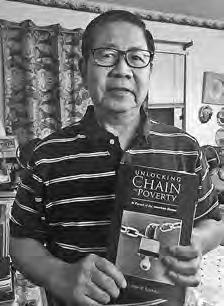
Estioko’s memoir details his Filipino family’s exploits in the United States who reluctant ly immigrated to the country at a time of declining global econ omy in the late 1990s.
His memoir showcases how necessity played a vital role in the Estioko family, prompting them to work harder and chased
every opportuni ty that came their way in pursuit of the “American Dream.”
Published by Xlibris Publish ing, the memoir includes a fore word written by former California District 25 Assem bly member and Taiwanese immigrant Kansen Chu.
“The book [is] a must-readbook for all immigrants,” wrote Chu in his foreword. “It serves as an inspiration, especially for
those who are new and starting their families in the US.”
“Unlocking the Chain of Poverty: In Pursuit of the American Dream” by Elpidio Estio ko is now available to order on Ama zon (https://www. amazon.com/Un locking-Chain-Pov erty-Pursuit-American/ dp/1669840476) and Barnes and Noble (https://www.barne sandnoble.com/w/unlock ing-the-chain-of-poverty-elpi dio-r-estioko/1142076449).
TASTE OF OAHU | Millwood Ohana Productions | First Friday of the month until December 2022, 4-10pm | Aloha Stadium | Enjoy a night with Hawaii’s best entertainments, family fun activities and over 50 food, craft and retails vendors. Tickets starts at $15 for ages 12 and older. For more information, contact (808) 533-9016.
HAWAII TRIENNIAL 2022 | Hawaii State Art Museum | Until December 3, 2022 | 250 South Hotel St Second Floor, Honolulu | Even though the HT22 even officially closed on May 8, Hawaii State Art Museum will be keeping their HT22 exhibit on display until December 2022. View the unique exhibits showcasing the fluid concept of Pacific Century interweaving themes of history, place and identity. Entrance is free.
LET’S ZUMBA | Filipino Community Center | Every Monday until December 2022 at 6:15pm | FilCom Center, Consuelo Courtyard, 94-428 Mokuola Street, Waipahu | Need to unwind in movement and dance after a long workday? Join the community as we Zumba through the evening. Only $5 per class. Proceeds go to support these program-types for FilCom Center.
20TH PUMPKIN FESTIVAL | Aloun Farms | October, 15-16, 22-23 and 2930, 8:30am to 5pm | Aloun Farms, 91-1440
Farrington Hwy, Kapolei | Harvest your own pumpkins, corn, stringbeans and sunflowers! There will be food and craft vendors, free hayrides, keiki activities, entertainment and a farmers market. Admission is $5 per person. Free parking. To stay updated, follow Aloun Farms on Instagram @alounfarmshawaii.
CULTURAL WORKSHOPS | Ilokano Language and Literature Program & Timpuyog Organization | October 26, November 30 and December 6 | University of Hawaii at Manoa | Connect with Filipino culture in this monthly cultural workshops from the UHM. Students are encouraged to register using their hawaii.edu email. Register at https://forms.gle/o14dP8MaeG7urDqJA. Here are the various workshop details: Tinikling, October 26, 2-5:30pm at Moore 117; Kadaanan Nga Agas (Ancestral Medicine), November 30, 1:302:45pm at Webster 116; and Eskrima, December 6, 3-5:30pm at Moore 253.

HOLIDAY TIPS FOR CAREGIVERS FROM THE ALZHEIMER’S ASSOCIATION | AARP Hawaii and Alzheimer’s Association Hawaii Chapter | December 6, 10-11am | Webinar | Get tips for caring for your older family members over the holidays. Register here: https://tinyurl.com/ DEC6ALZAARP. Fo inquiries, call 808-591-2771.
Kastoy ti bugas ti editorialko iti Ilo kandia Magasin, Setiembre-Ok tubre 1977. Ti ILOKANDIA ti timek ni Ilokano iti Hawaii kadagidi a panawen.
“Siririing a kanayon dagi ti adda nalawag ken nawada a panggepna iti biag. Ket tung gal tao, addaan iti kabukbuko dan a panggep. Ket uray ania man a kita ti pagduyosan, adda bukodna a direksion---giya ken bagnosna a mangisakad kadayta a panggep ken pag duyosan.
Ken ni Mannurat, wenno dagiti agtarigagay nga agbalin a mannurat iti bukod a pag sasao, wenno iti Literatura Ilokana, adda met bukodna a panggep ken direksion para iti dayta a tarigagay.
Maysa nga arapaap a ta laga ti biag ni mannurat. Iti panagsuratan, kas met la iti edukasion, agtultuloy ti pa nagadalna kadagiti mas epek tibo a wagas tapno papintasen ken patibkerenna dagitoy a balabala a sangsangalen ti pa nunotna kadagiti idea a rum beng a mangtun-oy iti panag suratna.
Dagita nga idea, pampa nunot ket bunga ti arapaap, kas iti panaginaw iti ina, adda sikogna a sinikog ti nawada ken nalawa a pampanunot.
Mauditayo kadi iti estilo, ekspresion ken lengguahe?
Datayo nga Ilokano ti maysa kadagiti kabaknangan iti pag sasao. Agbibiag ti kulturatayo gapu kadagiti nabaknang a literatura iti Amianan. Da tayo nga Ilokano ti maibilang pay a kaanepan nga agbuki bok kadagiti kabukbukodan a kannawidan kas iti folklores, samiweng, sala, dramaturgo, ken istoria, dagiti historical a pakasaritaan, kasta met dagiti leyenda. Ket ti Literatura Ilo kana, agingga kadagitoy, pab pabaknangentayo a di agres sat. Dagitoy ti gamengtayo. Dagiti balitoktayo, balitok a manmano a masarakan.
Diak man ammo no pud no ti kunada nga awan ti ru mang-ay wenno bumaknang a mannurat. Kunada ketdi a mamirmiraut ti maysa a man nurat.
Pudno man ken saan a pudno daytoy, adda dakdak kel a panggep ti mannurat iti bukodna a pagduyosan.
Apay a bukiboken dagiti researchers wenno agsuksu kisok dagiti pempen a libro, wenno pagiwarnak kadagiti naimeng ken natalged a bib lioteka?
Ni Mannurat, kayattayo man ken saan, adda dita a kasarsaritam babaen iti bileg ti plumana. Adda dita a ka in-innumanmo iti puso ken puso, iti rikna ken rikna. No inilalana man dagiti napa teg nga impormasion, maysa kadagitoy ti panggepna para kenka.
Saan nga eppes, saan nga
ubbaw, saan a barengbareng ti dana a sinurotna, dagiti ar amidna a binuyogan iti rikna, puso ken kararua, isip ken panawen ta saanna a dinadael a pulos dagiti gundaway iti nalinteg ken nawada a direk sion. Nalawag a pagturongan. Mayallatiw dagitoy napateg nga istoria ken pakasaritaan.
Saan nga aginkukuna ken agimbubulsek iti kinapudno. Ti kinapudno, isu ti agdama na, iti kanito a sinuratna ti ag dama, agbalin a pakasaritaan, agbalin a napateg, mapagtal kan, mapagsadagan nga im pormasion.
Kas paset ken galad a naikawes ken ni mannurat…
• Resourcefulness: manag sukisok. Saan a mapmap nek a mangammo ken mangtunton iti kinapudno
• Readiness: nakasagana latta
• Reliability: mapagtalkan
• Refutable: naimbag a pag wadan, dakkel a pammati ken panagtalek
• Referenceable: mapagtal kan dagiti imalditna
• Responsible: responsib li—saan a barengbareng
Bay-anna ti bagina a mailansa iti napateg a kina pudno no iti nagan ti Literatu ra Ilokana ti makaigapu.
Kukuatayo ti pagsa saotayo. Tangsittayo daytoy a kina-Ilokanotayo. Dagiti binatog, kayariganda dagiti namsek, nabagas, nabun-as a dawa, dawa ti biagtayo, dagi
ti gapuanantayo. Adda met bukod nga agamang, sarusar dagiti gapuanantayo. Kas iti met sabali a paduyosan ken propesion, adda latta pang gep a maisangrat itoy. Ket iti panagsuratan, ken panagipab laak ken panangilibro, may sa met a kinalinteg, maysa a hustisia, maysa a gundaway a situturong iti tay-ak ti Litera tura Ilokana ken iti bukodtayo a pagsasao, mangipakita no asinotayo nga Ilokano, mapapalan a pagsasao, banag nga itinto maysa a gundaway, agsaknap, agwarnak ket pa tiek a mainayonto a dakkel a pagsadagan dagiti adda man iti tay-ak ti edukasion, gobi erno ken dagiti agduduma nga ahensia ti turay. Dagiti institu sion, ospital, panggedan, ken dadduma a tay-ak.
Saanak a matda nga agpupug to, ngem iti bukodko a panangsirma ta, beyond my dream and imagi nation, with hope, clear ly, kitkitaek, nainsiriban, sirsirigek ti nainsikogan, ti pagsa saotayo nga Ilokano—da kkel ti ma sakbayanna iti nalawag
a direksion manipud iti na talged a pondasion: iti pa nagayat, panangpabaknang, panangsalimetmet daytoy nakayanakan a pagsasaotayo nga Ilokano.

Degree Ubae, LLC. 1284 Kalani St Ste D-107, Honolulu, HI 96744
